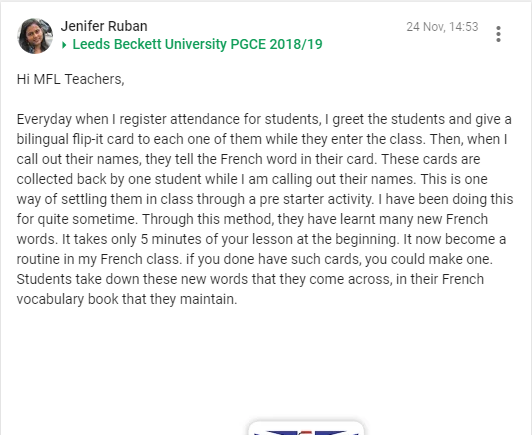PGCE Reflective Report: Professional Values and Practice
| ✅ Paper Type: Free Essay | ✅ Subject: Teaching |
| ✅ Wordcount: 4684 words | ✅ Published: 23 Sep 2019 |
Online PGCE Reflective Report
Professional Values and Practice
Contents
Sharing good Practice (part 4)
Introduction
This report is divided in four parts, the first part summarises my professional journey so far and provides a brief outline of my experience in a secondary school that has been rated “requires improvement” by Ofsted.
The Second part of the report will look at the host schools’ marking policy, with emphasis on the MFL department, and will explain the policy in detail, looking at how the policy had been implemented though the years.
The third part of the report will consider behaviour management, and during my power point presentation, a SEN student was observed over the course of a week, but only one day has been focused on, to see the differences on their behaviour during the day. The presentation will discuss the styles of teaching used, and how the student responded, and their behaviour impacted the lesson.
On part four of the report we will see a reflective summary of the discussion and shared resources, which is intended to help other Spanish teachers during their lessons.
Pen Portrait
My desire to teach comes from personal experience of growing up with both of my parents holding head teacher positions (my mother at a secondary school and my father at a university), along with various close family members who also hold head teacher positions. Their experience made me to want to follow in their footsteps, and they showed discipline and passion during their teaching years. They were successful in their careers, and helped shape many young peoples’ lives, and they were always recognised by the community as good example of people to follow.
My parents were role models for me and taught me what a Modern Foreign Language (MFL) teacher should be. For example, a self-motivated, talented bilingual professional, who is adaptable and disciplined, with excellent communication skills, highly reliable, organised, responsible and with high attention to detail.
I hold a university degree in economics, which I obtained during almost 8 years of working as an unqualified PE Teacher for one of the biggest universities in Venezuela. In this role, I developed and planned for extracurricular sporting activities programmes to suit varying cultures and skills levels of both individuals and groups.
I developed several key skills that every teacher should have such as diligence, determination, advanced organisational skills, along with complex time keeping. I have chosen to keep building on the skills that I had already started to establish. Choosing a main stream mixed secondary with a background of requires improvement, with that in mind I have been able to focus on developing my own classroom management skills and learn more about behaviour policy management.
On my arrival to UK over 9 years ago, I worked as a freelance Spanish tutor, which I found immensely rewarding by making a positive difference to a pupil’s learning experience and thus seeing their confidence grow. During that time I visited numerous homes from different economics backgrounds in London, I believe that all students deserve the best possible education, regardless of their background. Black and Wiliam mentioned that being a teacher, you “have to manage complicated and demanding situations, channeling the personal, emotional and social pressures of a group of 30 or more youngsters in order to help them […] become better learners in the future” (Black & Wiliam, 1998: p. 139).
I taught Spanish to beginners, intermediate and advanced learners, developing their listening, speaking, reading and writing skills. I placed a focus on communication, comprehension, discussion and conversational abilities, by using of different materials and techniques.
I am currently playing for three different basketball teams, this allowed me to develop many other key life skills, such as discipline, team spirit, leadership and planning skills. This academic year, I also volunteer to do extra hours coaching at my A placement school.
The school value expressed, “excellence in all we do” following this, I believe I have gained respect from the basketball students during my short time at the school, which is invaluable. When students see me around the school, they recognise the extra work I am doing for them, and they feel that I care for them and a connection is created. During lessons the same students’ behaviour has change in a positive way, when you compare to other lessons, and they are open to instructions, happy to put their hands up, thus helping the lesson run more smoothly.
I have had the opportunity to observe classes in both a grammar school and an academy, in various secondary year groups and sixth form classes. I found it interesting to compare the different teaching and behaviour management styles at both types of schools.
The focus for a teacher always need to be on the students that really want to learn, rather than the one, two or three that constantly disturb the lesson. During my working experience at the grammar school, I observed high behaviour expectations from the students, and the students’ behaviour was outstanding compared to that of the behaviour at the academy. The students at the grammar school were keen and highly motivated to learn a new language.
There appears to be a pattern in students who passed the 11 plus exam and attended the grammar school, in that they are more focused and interested in obtaining a good GCSE grade in Spanish, French or German. The behaviour management styles used at both schools are the same, but the process of the selective entry appeared to make a difference.
The UK school system is completely new for me, and my experience as a teacher at a university in Venezuela could not compare, but this could also be due to the age difference of the students. During my first month in the classroom, I initially found the pace of the lessons to be inadequate most of the time and ending on me running out of time, you only have one hour every lessons, meaning that you can’t go too fast or slow, and not everyone will follow the same rhythm, as some students will progress faster and others will need more attention. After I complete my PGCE, I am looking forward to become a MFL Teacher in a grammar school that allows me to also progress as a Basketball coach. I believe teaching is immensely rewarding, and it has always interested me, and offers great job satisfaction.
Policy Analysis
Students can often misunderstand their targets and how to improve upon their work in future assessments which makes it harder for them to “engage in appropriate action which leads to some closure of the gap” (Sadler, 1989: p. 121).
For part two of the assignment, I have selected to reflect on the Marking policy of my placement school. I will investigate the detail of the Marking policy and explain all the aspect of the policy for Modern Foreign Language MFL and explain how this then works at my placement school.
Spanish lessons are taught in two classrooms, and one lesson per fortnight in a computer room to allow students to learn to type in Spanish using accents and the letter ñ. The software used for all year groups in the computers room is ‘Linguascope’ which consolidates vocabulary and allows students to gain confidence in Spanish. AQA is the examination board used, and there is yearly subscription of the book ¡Viva! (from the publisher Pearson, designed to cover KS3 and KS4). However, the school is in the process of evaluating an upgrade of the subscription to include year 7 (if department budget’s constrictions allows). For KS4 they also have AQA GCSE foundation and higher materials and a very useful grammar and translation book. All the textbooks include access to an interactive book that can be used on the interactive whiteboards. They include exercises to cover the four key skills when learning a language: speaking, listening, reading and writing.
 https://www.robertnapier.org.uk/attachments/download.asp?file=1782&type=pdf
https://www.robertnapier.org.uk/attachments/download.asp?file=1782&type=pdf
There is a Marking and Feedback Policy to ensure that all children have their work recognised in such a way that it will improve progress and attainment and identify next steps, develop self-confidence, raise self-esteem and provide opportunities for self-assessment. As a result of this policy, there will be greater consistency in the way that pupil’s work is marked across the Key Stages.
Principles and Aims of the Marking and Feedback
The purpose of marking and feedback is:
- to celebrate achievement and efforts of a pupil’s school work, and to provide the next steps to help them improve;
- to confirm standards, individually, and within the class;
- to offer pupils the opportunity to respond to marking for improvement;
- to determine whether a pupil can work within set time limits or targets;
- to assess and evaluate against the success criteria;
- to measure the school’s progress against national expectation.
Marking and feedback should:
- Relate to learning intentions, success criteria and targets (including IEPs – Individual Education Plans), which need to be shared with pupils.
- Involve all adults working with children in the classroom, where appropriate.
- Be based on the pupil’s prior attainment within the context of marking towards the learning intention.
- Use consistent codes throughout the school. See Appendix for Marking and Feedback Guidelines.
- Be recorded appropriately when given in verbal form, e.g. individual/group conferencing with an adult.
- Give recognition and appropriate praise for achievement e.g. show another adult; a merit award; a sticker.
- Give clear strategies for improvement.
- Give time for children to read, reflect and respond to marking.
- Respond to individual learning needs, marking face-to-face with some and at a distance for others.
- Ensure all children, regardless of ability, are involved in the feedback and marking process (whether oral or written), so that progress is facilitated, and next steps identified.
- Ultimately be seen by children as positive in improving their learning.
- Inform future planning and group target setting.
- Be manageable for teachers.
Types of Feedback and Marking
Summative feedback/marking:
This usually consists of ticks, dots, circles etc. and is associated with closed tasks or exercises where there is a correct/incorrect answer.
Formative feedback/marking:
With oral and written feedback, in the course of a lesson, teachers’ comments to pupils should focus firstly on issues about the learning intention and IEP/writing/maths target, and secondly, in a quieter voice on an individual basis, on other features.
In Key Stage 3, students will complete an assessment at the end of every unit. Prior to this, staff review the books and address common misconceptions at the beginning of the assessment lesson. This is known as the Blue Review. The statements within the WWW and KPI are recorded on the school MIS and sent home as part of the reporting process. Verbal feedback is paramount to address immediately grammatical misconceptions.
All assessments are kept by the teacher and should be available to be seen at all times.
Teachers should have a blue review file which should contain the following as a minimum:
- SIMS data analysis for Key Stage 3/any data analysis from 4 matrix (Key Stage 4 only)
- PP students
- Class photos
- Class charts (profile of class)
- Learning support student profile (only for SEN students)
- Marking Crib Sheets for each term
 Teachers are required to complete a Marking Crib Sheet half way through a topic and after the assessment. In Key Stage 4, the focus is on, including translation, the development of the 4 skills required: listening, reading, speaking and writing. Due to the nature of these very different skills, the grade prediction varies. The teacher keeps a very close eye on a daily basis and constant support and feedback is provided.
Teachers are required to complete a Marking Crib Sheet half way through a topic and after the assessment. In Key Stage 4, the focus is on, including translation, the development of the 4 skills required: listening, reading, speaking and writing. Due to the nature of these very different skills, the grade prediction varies. The teacher keeps a very close eye on a daily basis and constant support and feedback is provided.
The last Ofsted report (2016) where the overall grade of the school was “Require Improvements” stated the follow regarding marking policy: “Pupils enter the school with below average attainment and often with weak literacy skills. English lessons do much to address these deficiencies but not all teachers are developing pupils’ literacy skills sufficiently in other subjects. In addition, the school’s marking policy is implemented inconsistently in literacy. This is slowing progress down.”
 https://www.robertnapier.org.uk/attachments/download.asp?file=420&type=pdf
https://www.robertnapier.org.uk/attachments/download.asp?file=420&type=pdf
It can be argued that the most fundamental use of assessment is to build pupils’ understanding and improve their learning within day-to-day lessons. (What are the fundamentals of assessment, 2018). There are lots of ways of how teachers keep track of pupil progress including recording ‘key performance indicators’ for every student. In the languages department, teachers must complete the key performance indicators section for every student once a term. This consists of allocating each pupil a mark of E (emerging), D (developing), S (secure) and M (mastered) for each skill that they have learnt each term. For example, one of the performance indicator’s for year 7 Spanish is ‘being able to describe the physical appearance of pets’. If pupils have accomplished this and are able to describe a pet’s appearance accurately in both spoken and written form, they will be awarded an ‘M’. However, should they struggle to do this without help, then they will be given an ‘E’. The decision of what mark is given is made through looking at and marking each pupil’s exercise book and also marking their end of unit assessment at the conclusion of each term.
I believe this system of monitoring data is extremely useful as it provides teachers with an overall view of pupil’s progress and they can then use this data to assess whether or not pupils are on target to achieve their potential grades. Sometimes this data may reveal that a pupil has struggled with all of the term’s work should they receive all E’s and D’s and this allows teachers to compare this to the individuals target grade. Should their target grade be high, it makes the teacher aware that this pupil needs to improve hugely in order to meet or exceed their target grade at the end of year 7. However, should the pupil have a low target grade, it indicates that although this pupil may need extra help to understand the work better, their expectations should not be excessively high. Furthermore, the ‘commitment to learning’ grade is very important as this may be affecting the student’s results. For example, if the pupil has received all E’s and D’s and also a low mark for commitment to learning, teachers can investigate further whether it is the student’s behavior in lessons which is effecting their learning overall.
Individual pupil feedback, those pupils who are making mistakes regarding the common class misconceptions will have their initials written next to the relevant mistake. In my opinion, this way of marking works fantastically well as it clearly sets out the common errors being made by pupils and allows teachers to plan subsequent lessons to fix these issues. The idea is that this input will improve pupil’s grades. There are of course some flaws with this system as evidently not all pupils will have made all the same errors and they might not particularly need additional help.
However, all feedback is useful and I think they will still find the lesson planning actions helpful as it should prevent them from ever making these mistakes in the future. Furthermore, teachers at the school plan interventions for pupils who are struggling more than others. For example, in order to make sure that these students improve in that skill, teachers will sometimes set differentiated homework where the work for these pupils will focus mainly on the area they struggled with in class. I think this is a great idea as not only will pupils be able to practice the area in which they are most weak, but this differentiation allows teachers to analyse whether the student has improved or not. Hattie (2011) considered that teachers may claim they give much feedback, but the more appropriate measure is the nature of feedback received and this is often quite little. (Hattie, 2011).
Therefore it is not important how much feedback is provided but in fact the quality of the feedback delivered which makes all the difference. Copping (2016) agrees stating that the quality of the feedback, however given, will be seen in how a pupil is able to tackle subsequent work. She adds that marking is a vital element of teaching, but when it is ineffective it can be demoralizing and a waste of time for teachers and pupils alike. Additionally, there is very little evidence to suggest that extensive written comments on every piece of work improves pupil outcomes in the long term. (Copping, 2016).
I believe that best practice in the classroom consists of including lots of mini plenaries throughout the lesson and a good plenary at the end of the lesson to assess pupil’s learning. I think that a good plenary is an evaluative activity of what happened during the lesson, allowing the teacher to evaluate if the lesson’s objectives have been met and rounding off the lesson, consolidating some of the learning. In my opinion plenaries are essential as they bring lessons to a sharp close and allows the teacher to evaluate its success. They also assist teachers in planning follow up work and setting or adjusting targets for the class, groups or individuals. (What is the plenary for? 2018). What’s more, I often create starters for my classes to reflect on learning from the previous lesson and often assessing this learning. Starters could involve mini quizzes, matching up exercises or fill in the gap activities, as examples, to test pupils’ knowledge and to show me how much information they have retained from the last lesson. I will often record their marks in my marking folder in order to reflect on this information and help to plan future lessons. For example, if the majority of marks were low for one particular starter activity, I will make this topic a priority to re-cover in a future lesson and retest pupils after the topic has been revised. In addition, I believe assessment for learning throughout the lesson is enormously important, even if the marks are not necessarily recorded. For example, quick question and answer rounds with randomly selected pupils or vocabulary games on the interactive board may not generate marks, but teachers can assess the answers given and evaluate how much the pupils understand. This can influence their decision on whether or not to move on to the next activity or perhaps go back over the previous learning in order to ensure that pupils have understood that part of the lesson before moving on. Also, I think peer assessment and self-assessment are tremendously essential in all lessons to give pupils the opportunity to evaluate their own/someone else’s work first before simply marking it correct or incorrect.
After analysing and investigating in detail during term 1 and part of term 2, of how the marking policy is applied to the MFL department, I can critically reflect on the effectiveness. We should use feedback as a responsive teacher, in this case feedback should not be an accountability measure, having no impact on student learning, quantity focused and overly time consuming.
We need to change the traditional way, summative; Teach- Assess- Grade- Respond to a Formative way, where Teach- Assess – Respond- Assess, in this way we will be using feedback as a responsive teacher.
This will create a better policy where we can for example, provide more effective forms e.g. whole class feedback, evidence informed practice, ensuring students act upon feedback, addressing workload issues, not an accountability measure but an aid for student progress, written feedback for student’s best work.
In conclusion, I believe that the key ingredients for successfully tracking and recording pupils’ progress is to consistently assess learning in lesson time, with the inclusion of plenaries, reflect on marks for assessments and compare these individual marks with the pupils’ target grades overall, and keeping data on an easily accessible, clear system. Furthermore, it is more important how teachers then use this information to positively impact the student. Through clear, concise feedback and well planned lessons and interventions, pupils have the ability to improve and show progression with the intention of reaching their target grades.
Case Study
See attached presentation.
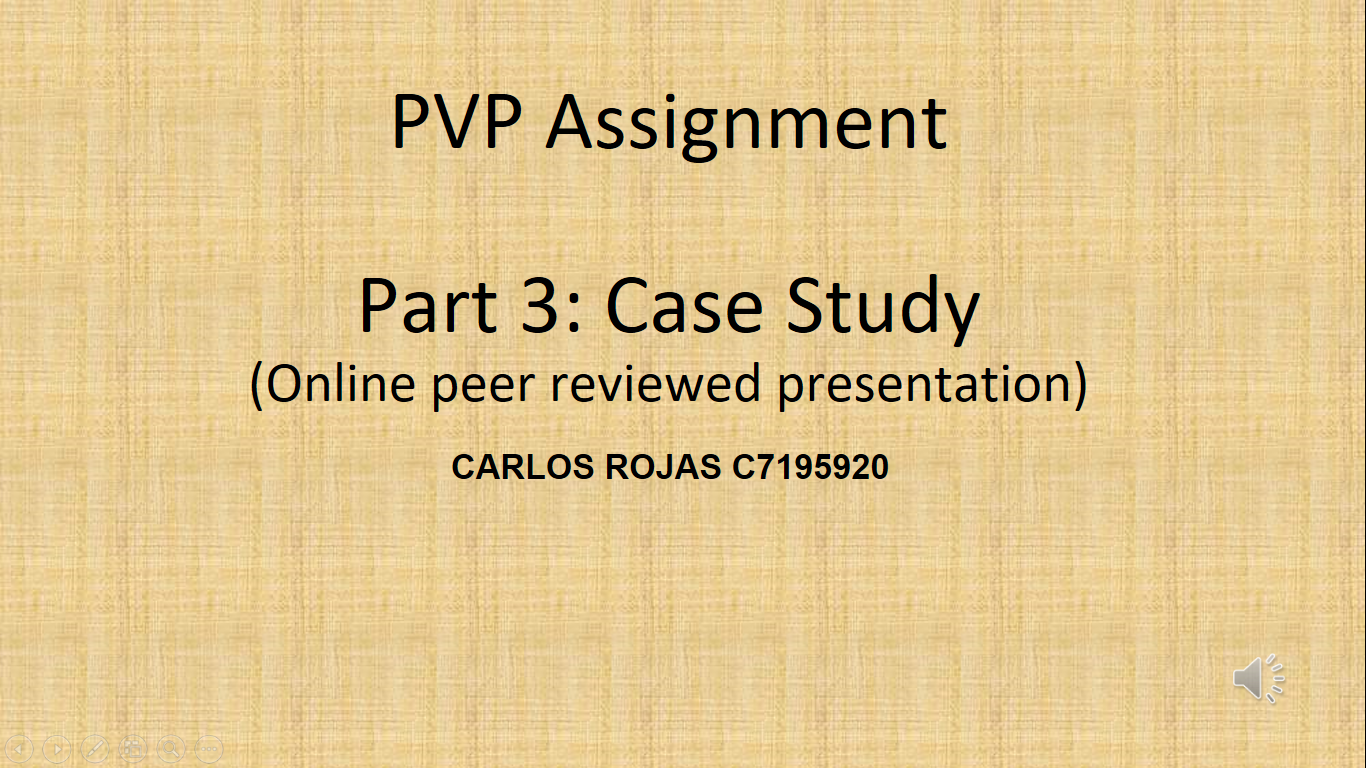
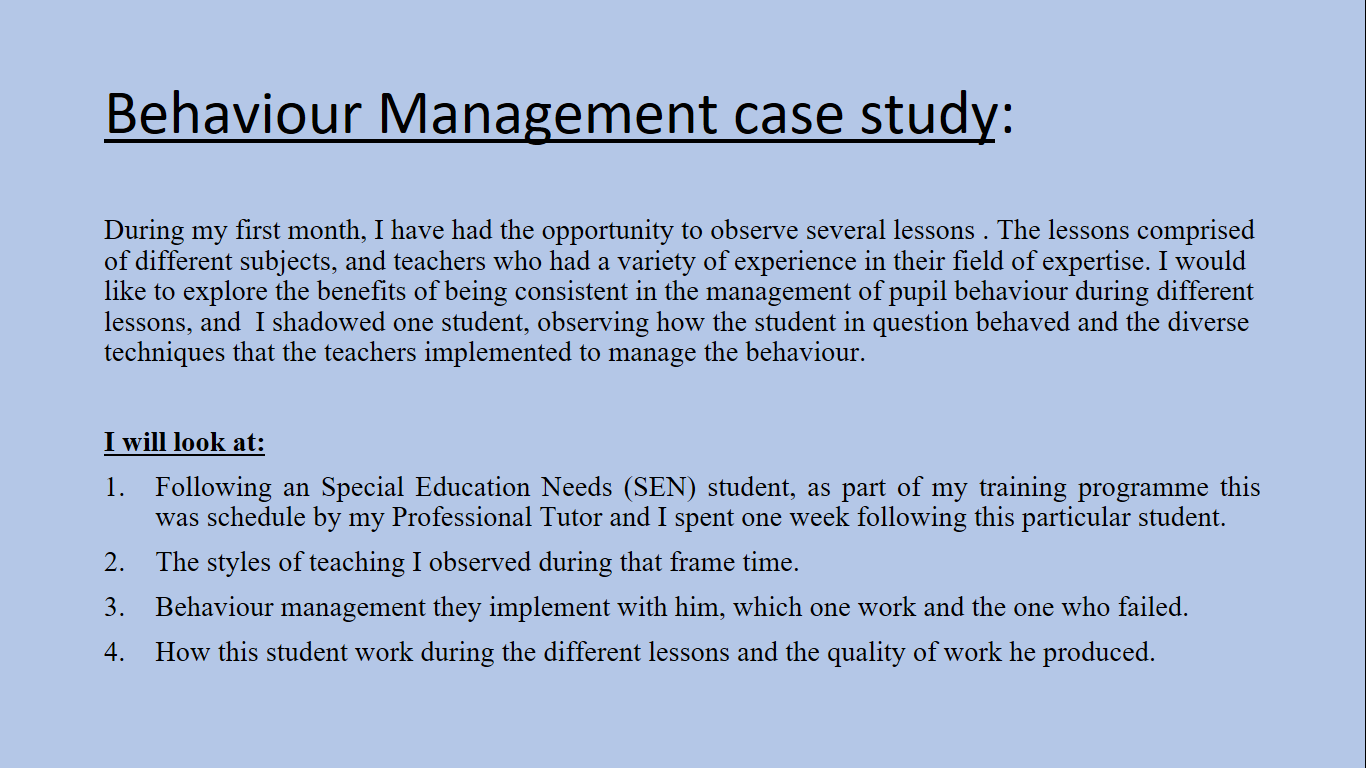
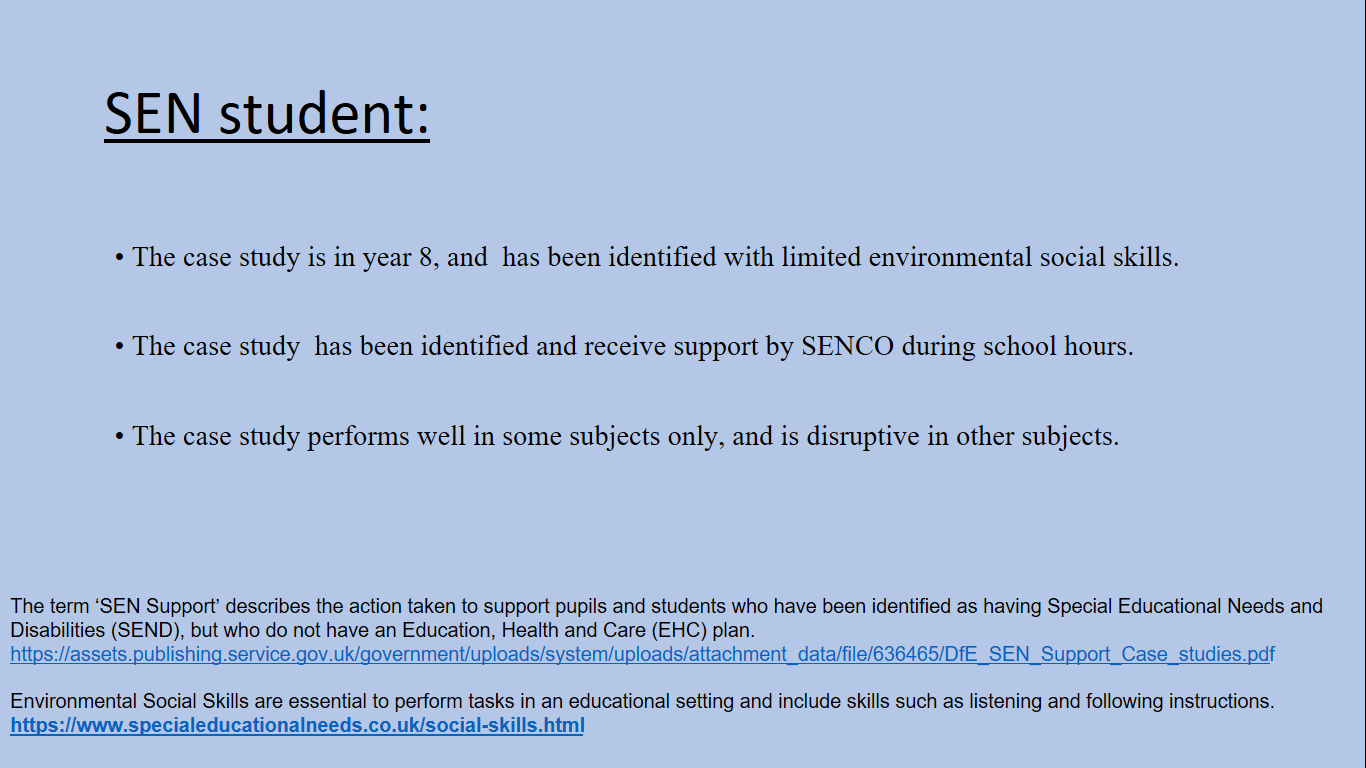

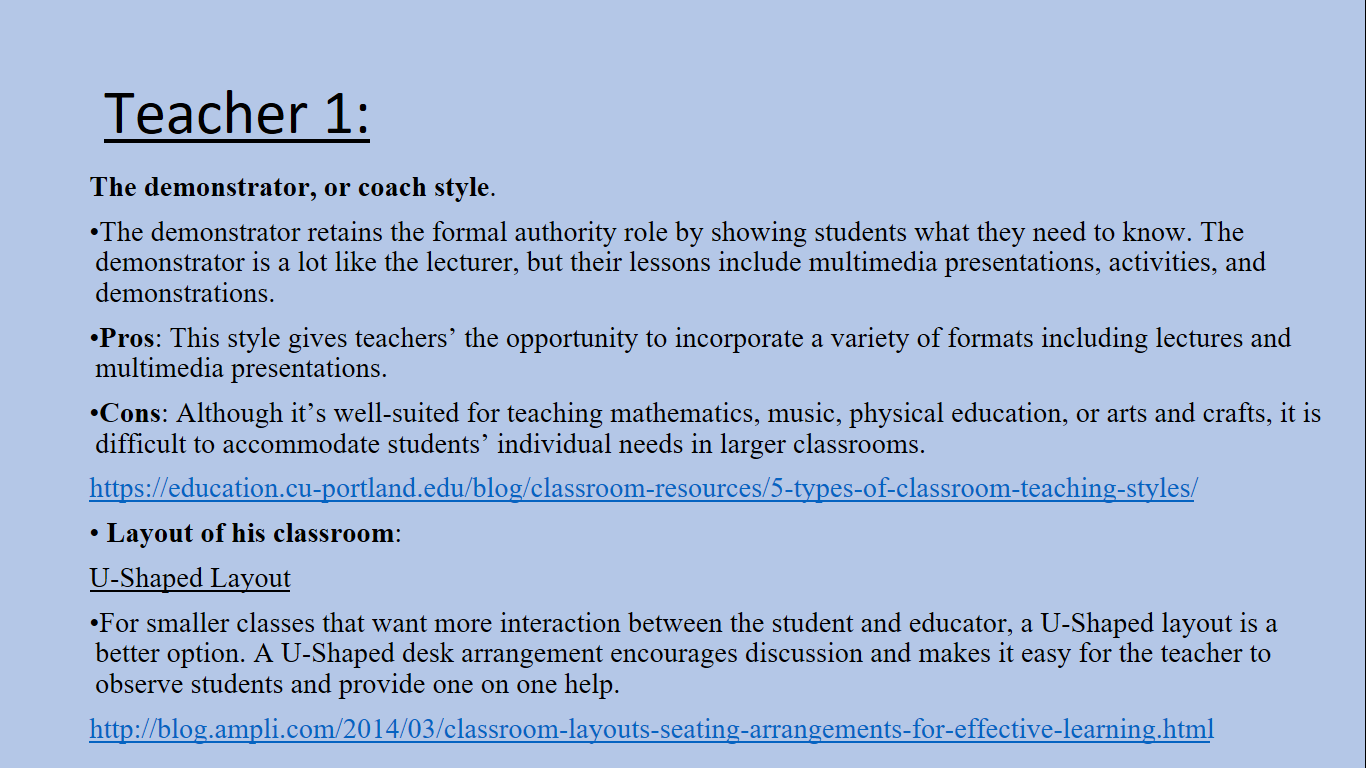
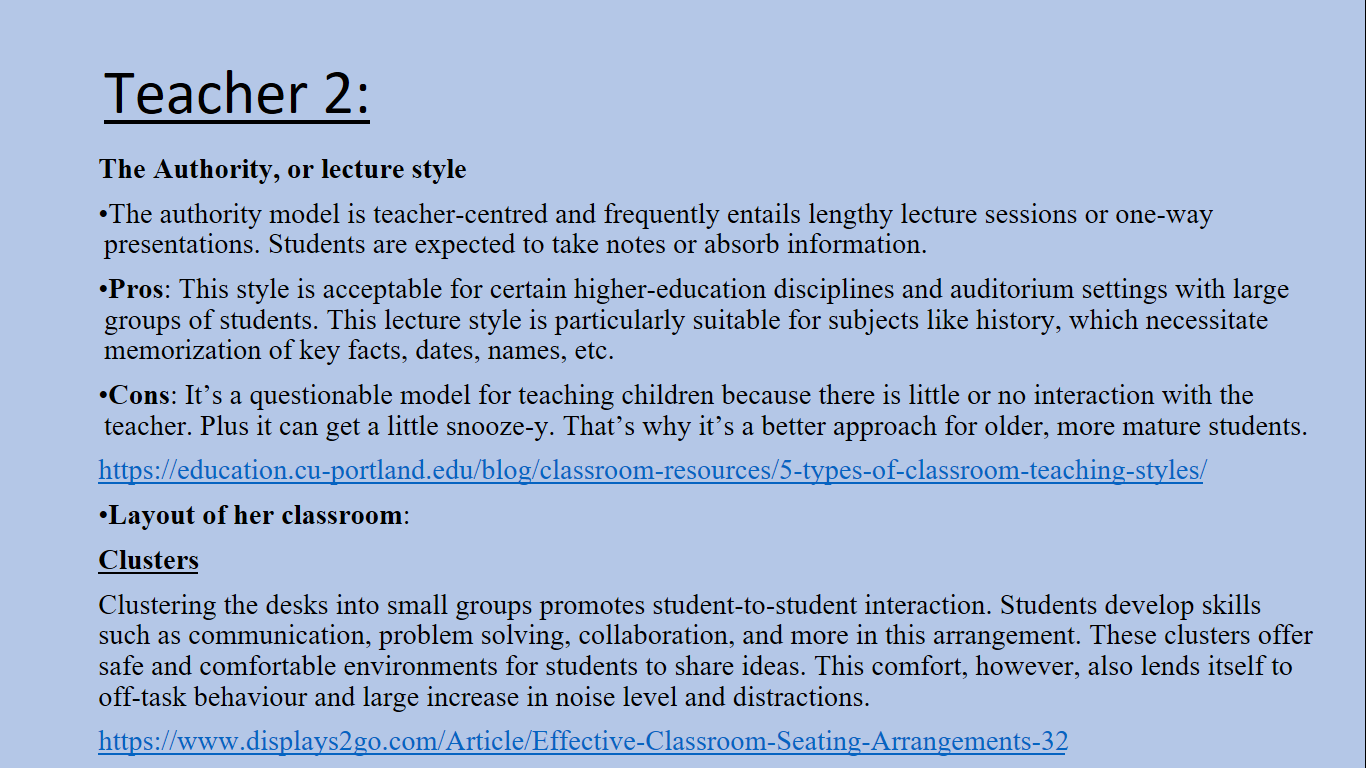
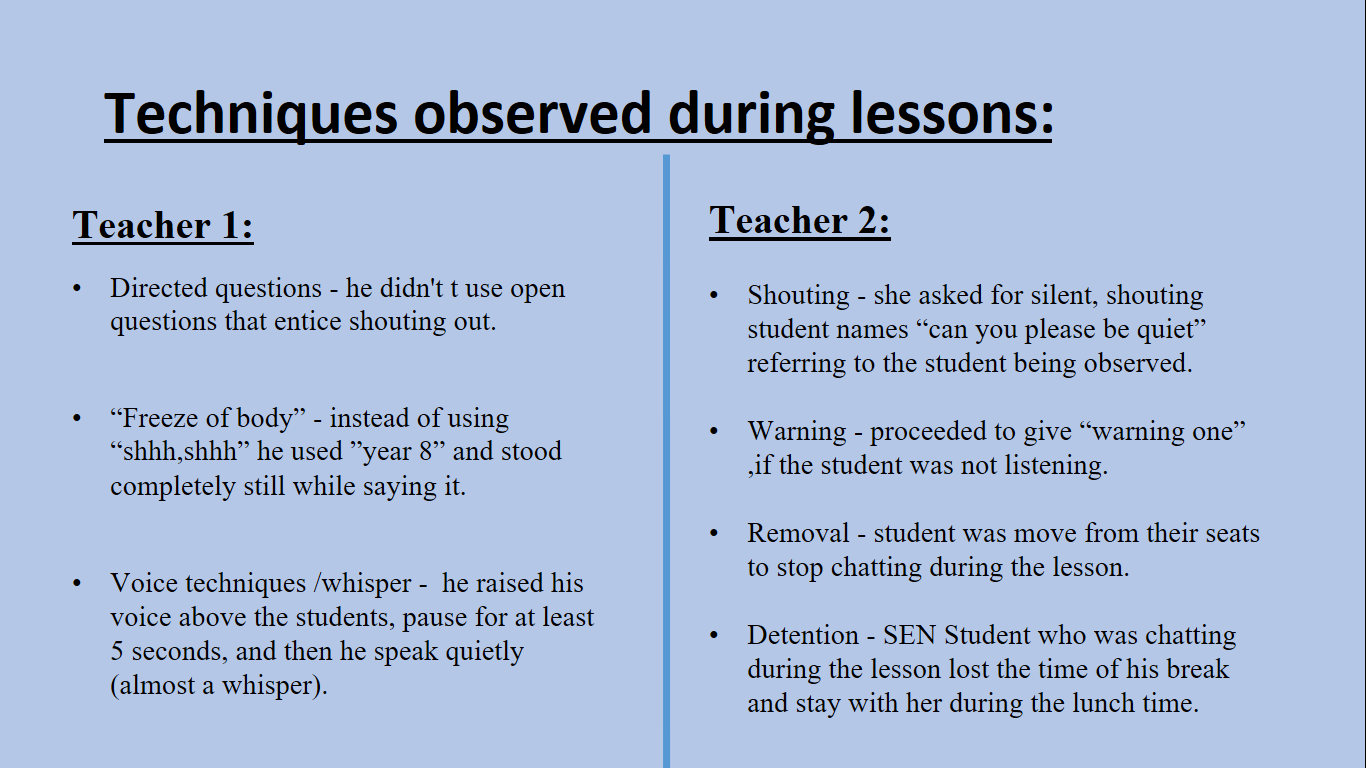

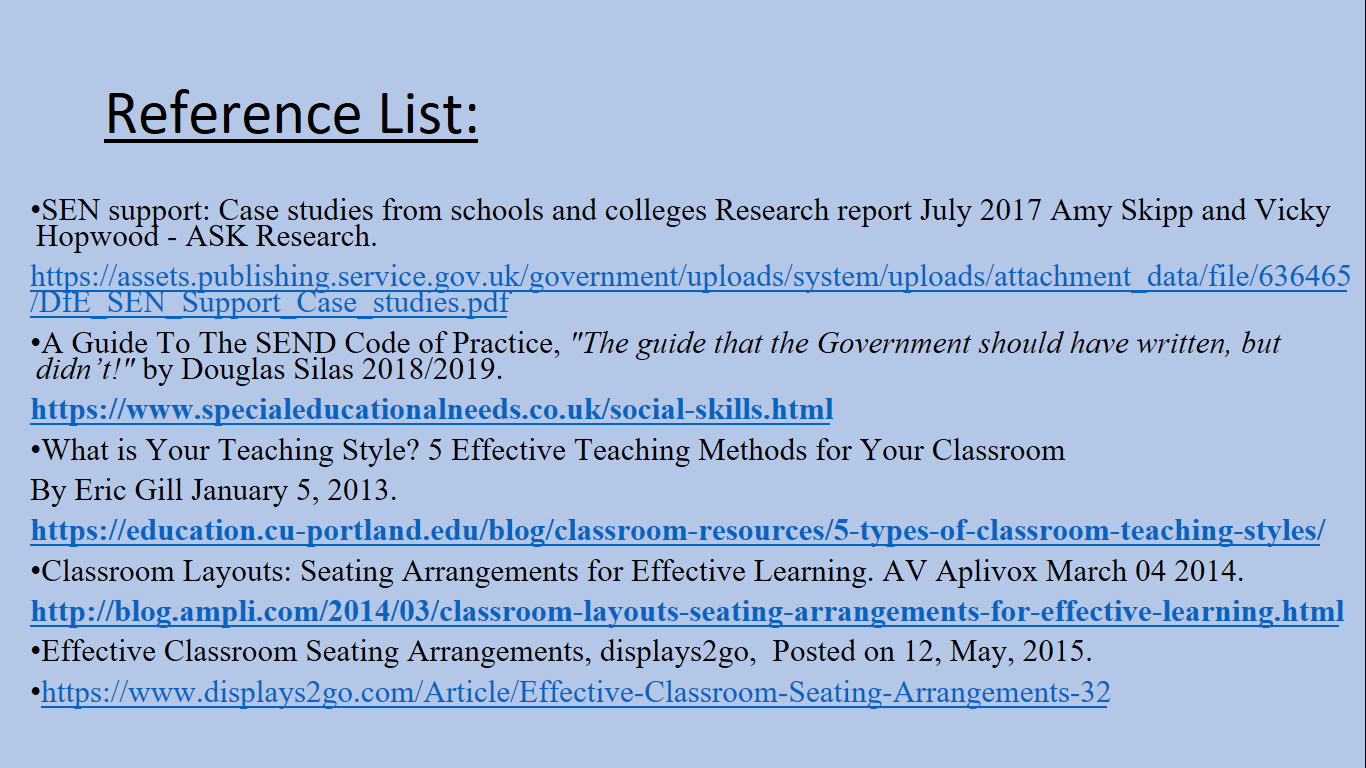
Sharing good practice
Resource 1.
I share this learning resource, “La vida es maravillosa – Life is wonderful”. Yokoi Kenji is a Colombian-Japanese speaker who travels around the world, and this resource shares the story and learning gained from his teacher Mr. Saito Satoshi. He states the way you engage with your students and the positive energy you share with your students make the different in every day lessons, when a student like you he then will behave better for you. Is important to remember always the reason why we choose to teach and influence we can be to our students.

Resource 2.
‘How to teach…..Spanish’, is an article by The Guardian-Teacher Network, which I found very interesting to read, as being new to teaching a foreign language at my placement school, the level of compromise or effort the students show to this subject is minimum, or almost none. This is not the case when I spent my ten work experiences days at a grammar school, where the numbers of student who chose to do GCSE Spanish was considerable higher than the current levels at my placement school (i.e. only 6 students are present in the year 9 class at my current placement). The grammar school also has a good take up of additional languages such as French, German or Italian, whereas in my currently placement only Spanish is taught.
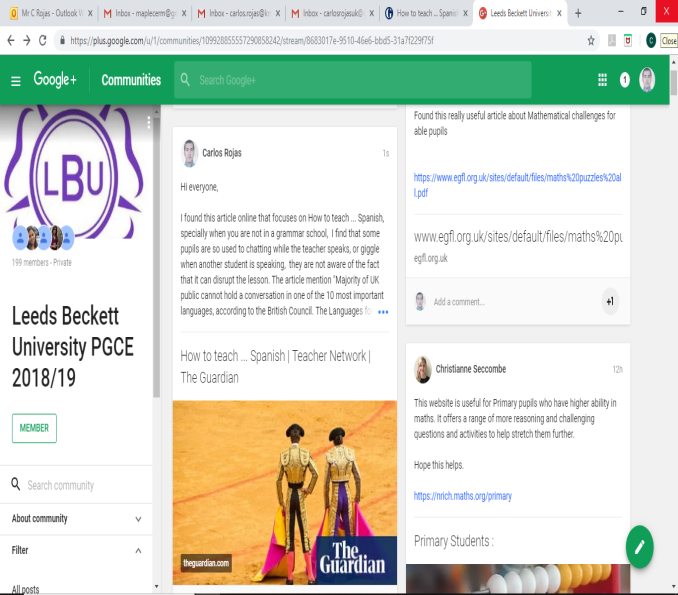
Resource 3.
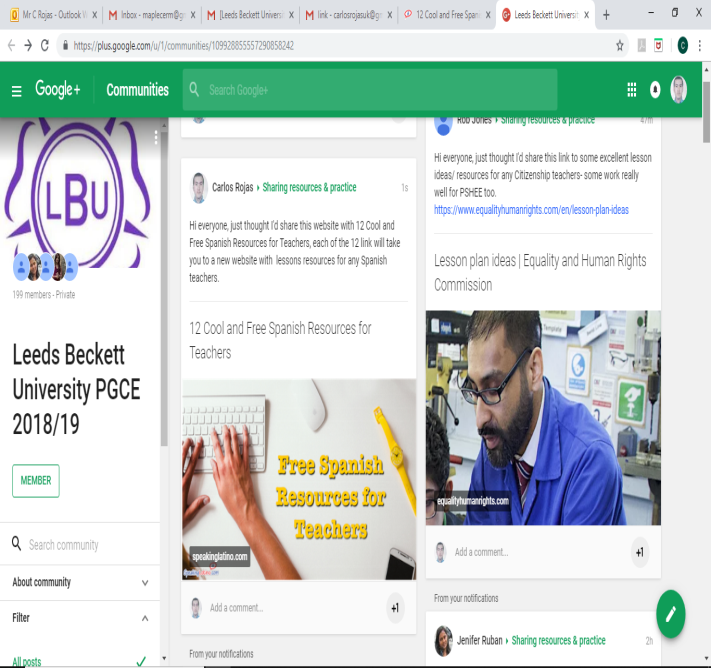 As a MFL teacher, there is an obvious lack experience in the classroom and a lack of resources i.e. every lesson needs to be prepared and planned before, which can be time consuming. After looking for assistance resources and solutions, I found the following website, that provides twelve different resource links, which allows you to choose from a wide range of resources that can be used as ideas or download activities for listening, visuals or worksheets.
As a MFL teacher, there is an obvious lack experience in the classroom and a lack of resources i.e. every lesson needs to be prepared and planned before, which can be time consuming. After looking for assistance resources and solutions, I found the following website, that provides twelve different resource links, which allows you to choose from a wide range of resources that can be used as ideas or download activities for listening, visuals or worksheets.
PGCE Google map.
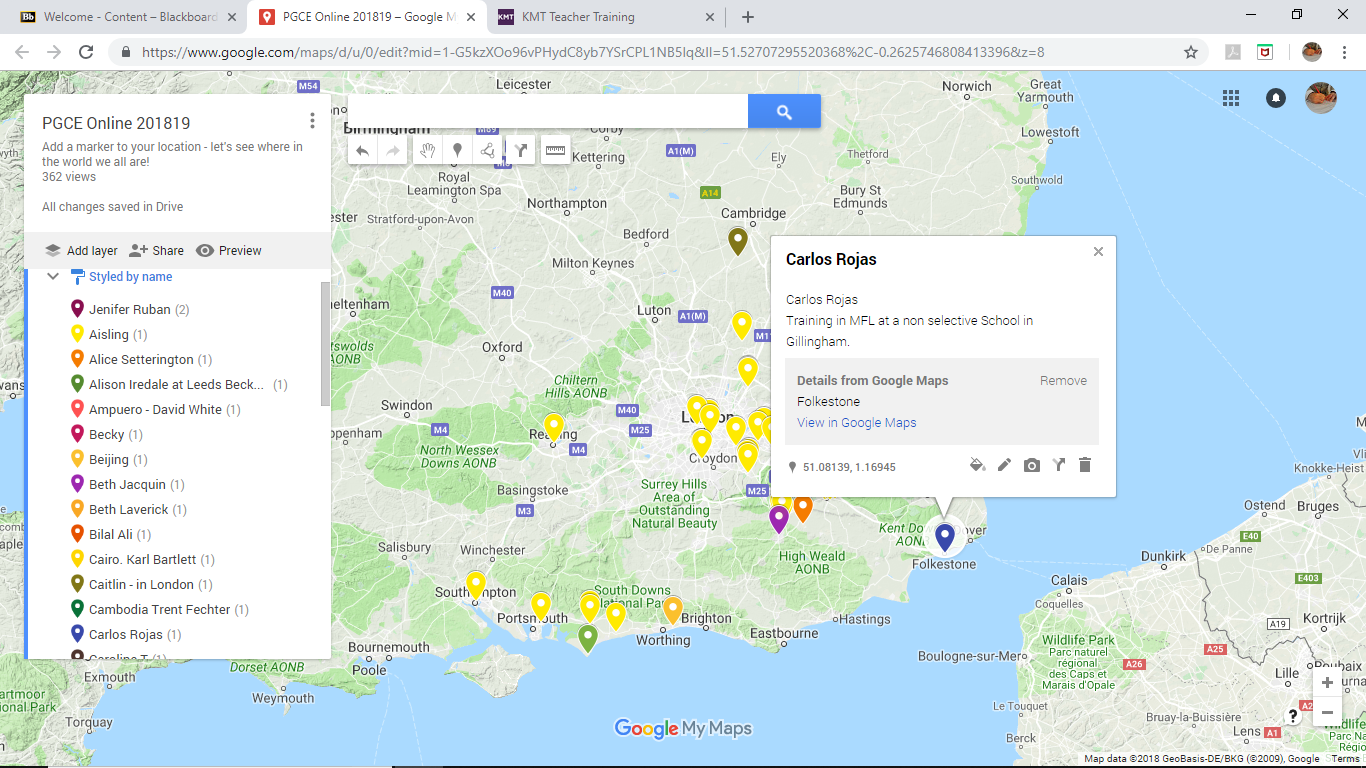
Comments.

Conclusion
[a short reflection on what you have learned in this module]
Conclusion
This PGCE online reflective report begin explaining my journey so far into teaching and reflected on how my personal values related to the professional values of being a teacher in the UK.
For the second part of the report, I selected to reflect on the Marking policy of my placement school, specifically the Modern Foreign Language Department (MFL) This was explained covering all details of the Marking policy during the academic year, I reflected on how the marking policy should be done, to achieve better results.
The PVP assignment focus on one particular year 8 SEN student, I shadowed him and observed how the student in question behaved and the diverse techniques that the teachers implemented to manage his behaviour, proving that being consistent during the lessons will achieve better results in the management of pupils behaviour during different lessons.
The final part of the report, shows, in different screen shots, all the online resources I shared with my Spanish teachers colleague, with some opinions regarding my shared resources. My intention was to help to the ones like me, new to the teaching environment and in need of resources to create their lessons.
References
- Black, P. & Wiliam, D. (1998). Inside the Black Box: Raising Standards through Classroom Assessment. The Phi Delta Kappan [Online]. 80 (2), pp. 139-148.
https://www.jstor.org/stable/20439383
- Sadler, D.R. (1989). Formative Assessment and the Design of Instructional Systems. Instructional Science. 18, pp. 119-144.
- Copping, D. (2016). Eliminating unnecessary workload around marking.
- Hattie, J. (2011) Feedback: The communication of praise, criticism, and advice.
http://visible-learning.org/2013/10/john-hattie-article-about-feedback-in-schools/
- What are the fundamentals of assessment? (2018).
http://www.aaia.org.uk/assessing-without-levels/what-are-the-fundamentals-of-assessment/
- What is the plenary for? (2018).
.
• SEN support: Case studies from schools and colleges Research report July 2017 Amy Skipp and Vicky Hopwood – ASK Research.
• A Guide To The SEND Code of Practice, “The guide that the Government should have written, but didn’t!” by Douglas Silas 2018/2019.
https://www.specialeducationalneeds.co.uk/social-skills.html
• What is Your Teaching Style? 5 Effective Teaching Methods for Your Classroom By Eric Gill January 5, 2013.
https://education.cu-portland.edu/blog/classroom-resources/5-types-of-classroom-teaching-styles/
• Classroom Layouts: Seating Arrangements for Effective Learning. AV Aplivox March 04 2014.
http://blog.ampli.com/2014/03/classroom-layouts-seating-arrangements-for-effective-learning.html
• Effective Classroom Seating Arrangements, displays2go, Posted on 12, May, 2015.
https://www.displays2go.com/Article/Effective-Classroom-Seating-Arrangements-32
• The Rober Napier School, Subject Overview MFL, 2018 – 2019
https://www.robertnapier.org.uk/attachments/download.asp?file=1782&type=pdf
• The Robert Napier School, School Ofsted Report, Overall effectiveness Requires improvement, Overall effectiveness at previous inspection Requires improvement. Inspection dates 15–16 September 2016.
https://www.robertnapier.org.uk/attachments/download.asp?file=420&type=pdf
Appendices


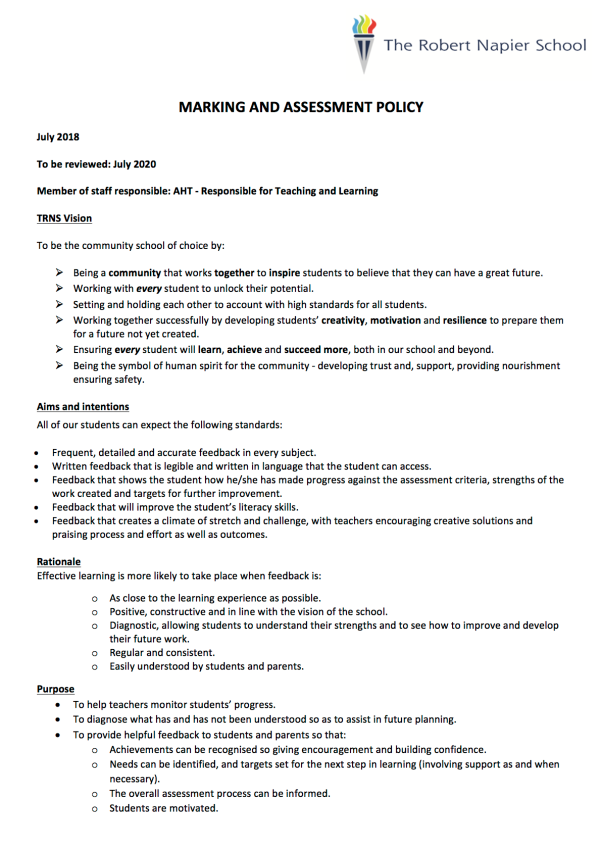

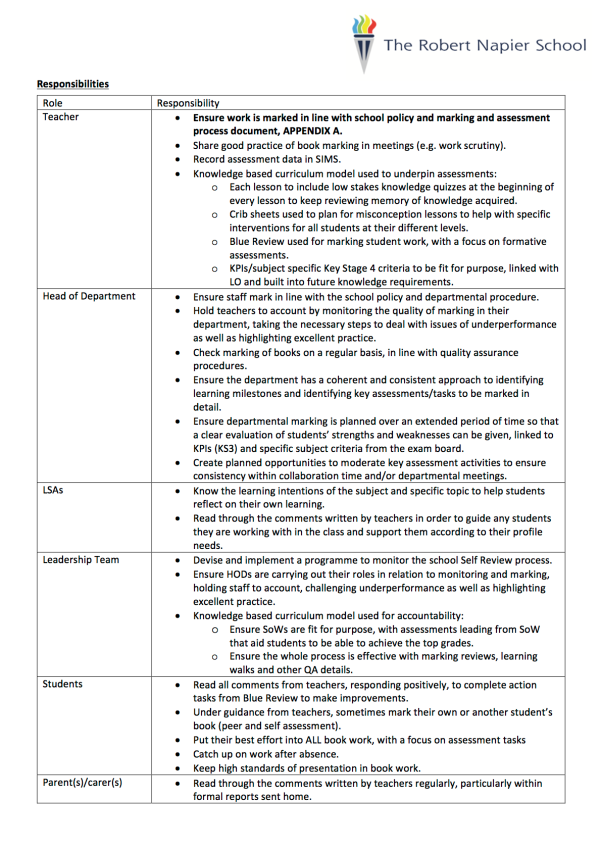

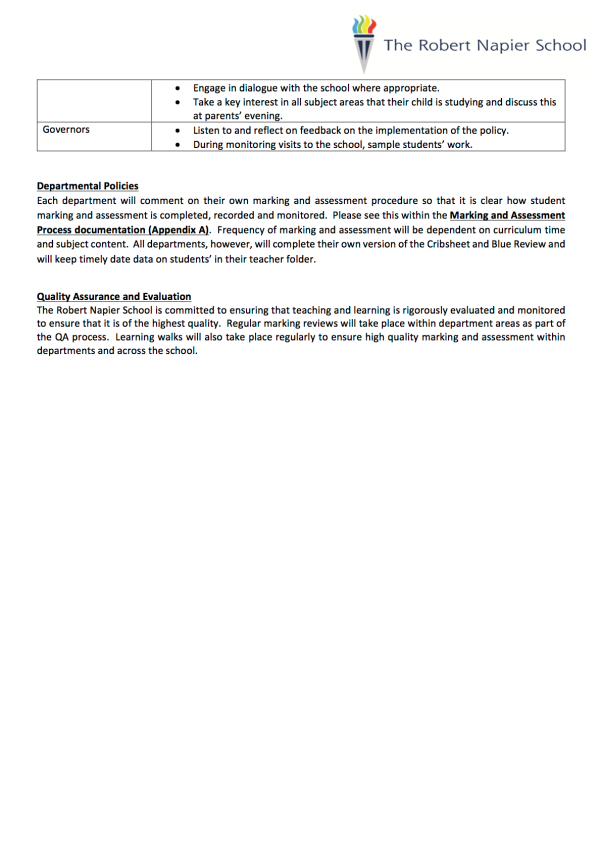

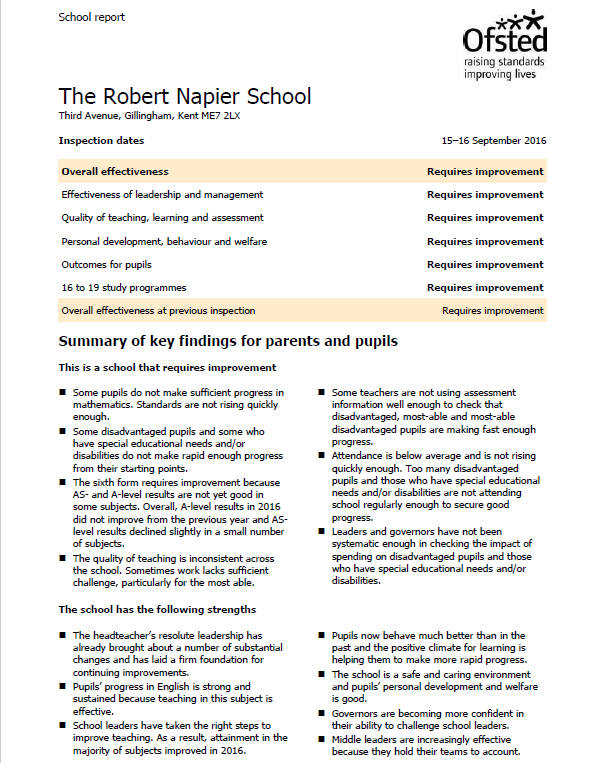
Online PGCE-Professional Values & Practice:
Behaviour management case study presentation
Name: Sherie McCormick | 77198235
Title: Carlos Rojas – Part 3: Case Study (Online Peer Reviewed Presentation)
|
Module Learning Outcomes |
Comments |
|
Demonstrate, through personal reflection, a thorough and critical understanding of the professional values and practices associated with a skilled practitioner. |
Carlos starts by explaining the importance of reinforcing consistent behaviour management strategies as a whole school policy, thinking carefully about how different techniques are used cross-curricular. Carlos gives context to his case study, providing information about the student he shadowed and their SEN background, but also the context of the teachers he has observed and their backgrounds in education. Carlos details the classroom layout and the particular teaching style of each observation – the ‘Demonstrator’ style for Teacher 1 and the ‘Authority’ style for Teacher 2. He outweighs the positives and negatives for each style of teaching and incorporates information about the classroom layout within his presentation. |
|
Critically reflect upon data from a range of sources to evaluate the effectiveness of behaviour management, pastoral care and teaching and learning across educational settings.
|
In the presentation, Carlos discusses the techniques used by each teacher and how this impacts on the specific student he shadowed. He makes it clear that the special educational needs of the student were effectively met in Teacher 1’s lesson who fosters a safe and calm learning environment meaning that the student in question “[responded] well”, “did not disturb the lesson” and produced work “to a good standard”, all of these complemented with positive praise. This is then counteracted with the feedback for Teacher 2 who struggles to meet the additional needs of the pupil. As a result of this, the student begins to participate in low-level disruption and does not respond well to the member of staff. |
|
Demonstrate synthesis of theories and professional practice within the context of the participant’s role within education. |
Carlos uses specific sources when referring to definitions, the impact of seating plans and teaching styles. These sources start to provide some useful information for the presentation, but perhaps more research based sources, such as journals, could have been used to further strengthen the ideas suggested. |
Cite This Work
To export a reference to this article please select a referencing stye below:
Related Services
View allDMCA / Removal Request
If you are the original writer of this essay and no longer wish to have your work published on UKEssays.com then please click the following link to email our support team:
Request essay removal

